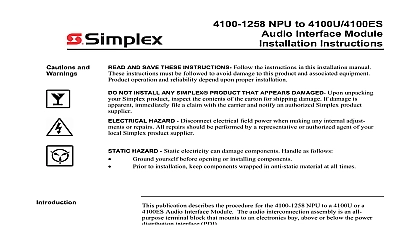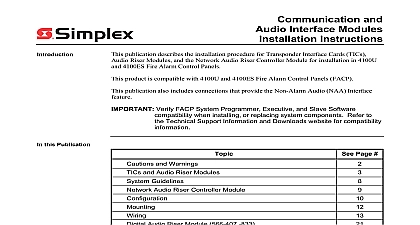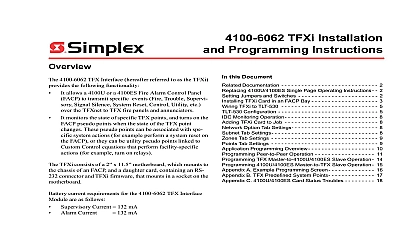Simplex Installation Instructions TFX Audio Interface Module

File Preview
Click below to download for free
Click below to download for free
File Data
| Name | simplex-installation-instructions-tfx-audio-interface-module-7250318469.pdf |
|---|---|
| Type | |
| Size | 1.06 MB |
| Downloads |
Text Preview
4100 1340 TFX Audio Interface Module Instructions AND SAVE THESE INSTRUCTIONS Follow the instructions in this installation manual These instructions must be to avoid damage to this product and associated equipment Product operation and reliability depend upon proper NOT INSTALL ANY SIMPLEX PRODUCT THAT APPEARS DAMAGED Upon unpacking your Simplex product the contents of the carton for shipping damage If damage is apparent immediately file a claim with the carrier and notify authorized Simplex product supplier HAZARD Disconnect electrical field power when making any internal adjustments or repairs All repairs should performed by a representative or authorized agent of your local Simplex product supplier HAZARD Static electricity can damage components Handle as follows Ground yourself before opening or installing components Prior to installation keep components wrapped in anti static material at all times SAFETY HAZARD Under certain fiber optic application conditions the optical output of this device may exceed eye limits Do not use magnification such as a microscope or other focusing equipment when viewing the output of this device RULES AND REGULATIONS PART 15 This equipment has been tested and found to comply with the limits for a Class A digital pursuant to Part 15 of the FCC Rules These limits are designed to provide reasonable protection against harmful interference when the is operated in a commercial environment This equipment generates uses and can radiate radio frequency energy and if not installed used in accordance with the instruction manual may cause harmful interference to radio communications Operation of this equipment in a res area is likely to cause harmful interference in which case the user will be required to correct the interference at his own expense REACCEPTANCE TEST AFTER SOFTWARE CHANGES To ensure proper system operation this product must be tested in with NFPA 72 after any programming operation or change in site specific software Reacceptance testing is required after any change or deletion of system components or after any modification repair or adjustment to system hardware or wiring components circuits system operations or software functions known to be affected by a change must be 100 tested In addition to ensure that operations are not inadvertently affected at least 10 of initiating devices that are not directly affected by the change up to a maximum of 50 must also be tested and proper system operation verified 4100 1340 TFX Audio Interface module converts 10 Vrms 4100U or 4100ES analog outputs 0.77 Vrms signals compatible with the AUTOCALL AMP 96 audio riser During a TFX or TFX 800 to 4100U or 4100ES master panel migration the TFX Audio Interface module a means to retain existing AMP 96 speaker circuits publication covers the installation procedure of the TFX Audio Interface module into a or 4100ES Master control panel this publication discusses the following topics Page to TFX Audio Interface Module the TFX Audio Interface Module 2011 SimplexGrinnell LP All rights reserved and other information shown were current as of publication and are subject to change without notice and the Simplex logo and AUTOCALL are trademarks of Tyco International Ltd and its affiliates and are used under license C following terms are defined addressable devices Power Distribution Interface TFX 500 TFX 800 series fire alarm panel 4100 1340 TFX Audio Interface Module interfaces the 4100U 4100ES Analog Audio to existing AUTOCALL TFX AMP 96 amplifiers It provides an AMP 96 compatible riser by converting the 10 Vrms audio signal from the 4100U 4100ES PDI to a 0.77 Vrms It provides a transformer coupled output that is trim pot adjustable to 0 dBm 6dB This is similar to the TFX Riser Driver 2 board 1 TFX Audio Interface Module System Interconnection to TFX Audio Interface Module card is a flat 4 x5 form factor module that plugs into the 4100U 4100ES power distribution 2 TFX Audio Interface Module 24VDC Supervisory or Alarm Current Power 29mA maximum Operating Temperature 32 to 120F 0 to 49C Humidity Up to 93 relative humidity at 90F 32C module has four external connectors TB1 is a 3 position terminal block for audio signal field wiring Refer to Table 1 1 TB1 Connections 1 2 3 on next page to TFX Audio Interface Module Continued 2 is a 3 position shield jumper Refer to Table 2 for pinout description 2 P2 Jumper Position shield connection shield connection default P4 is a 6 position header used to select between Audio1 or Audio2 riser inputs setting is Audio Riser 1 P4 positions 1 3 and 2 4 select Audio Riser 2 move jumpers to P4 positions 3 5 and 4 6 Audio Riser 1 is only available for use with TFX Audio Riser 2 is reserved for non TFX appliacations R1 is an adjustable trim pot used to change the output audio by 6dB 3 Trim Pot Position audio output audio output on next page to TFX Audio Interface Module Continued Wiring 3 shows fields wiring information 3 Field Wiring Notes All wiring to be in accordance with NEC National Electronic Code local authorities and notes All wiring in the audio system is Power Limited Disconnect power before servicing the system All conductors must be free of grounds The Audio Riser should be terminated at the source of the Audio Riser at the Audio Riser Card Audio Riser Twisted shielded pair 75 ohms maximum All wiring is supervised by the Amp96 Ground detection 10 Kohm note this is detected and reported by the AMP 96 RPS424 Maximum circuit voltage is 0.84Vrms Size 12 18 AWG 3.31 0.82 mm2 to TFX Audio Interface Module Continued Wiring Fault Detection of Audio Riser output of the riser driver transformer is referenced to DC common of the power supply that is to power the amplifier system Because the riser is referenced to DC common ground fault of the audio riser is possible one power supply used in the system with same DC common should have ground fault enabled If the other power supplies are used in a system with the same DC common together their ground fault circuits should be disabled for proper ground fault detection Level Calibration Audio Riser requires calibration so that the level of the audio signal at the end of the Audio is 0dBm 0.77Vrms To achieve this follow the following steps At the originating point of the Audio Riser place the calibration potentiometer to midrange Make sure the 4100U 4100ES Analog Audio controller is playing the 1KHz supervision tone Ensure that the Audio Riser is properly terminated Measure the audio The end of the Audio Riser is the last AMP 96 Amplifier connected to the riser 1 10 AMP 96 Amplifiers connected to the riser use the 750 Ohm P N 976448 resistor 11 20 AMP 96 Amplifiers connected to the riser use the 4.7k Ohm P N 976449 resistor 21 25 AMP 96 Amplifiers connected to the riser no termination resistor is required Measure the riser signal level at the end of the riser or riser subsection by measuring the AC at terminals TB2 1 and TB2 2 of the AMP 96 Amplifier or at the TB1 1 and TB1 2 or and TB2 2 of the CS2 Channel Select Board Adjust the RISER GAIN potentiometer R1 on the Audio Interface board so that the voltage at the end of the riser is 0.77VRMS 0.07V the TFX Audio Interface Module 4100U 4100ES TFX Audio Interface module mounts on a PDI in a 4100U 4100ES expansion It can be mounted on any available block Refer to Figure 4 4 Mounting TFX Audio Interface Module C


